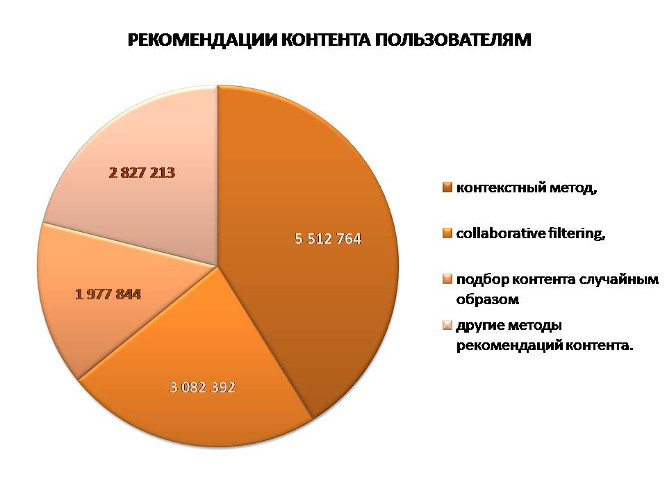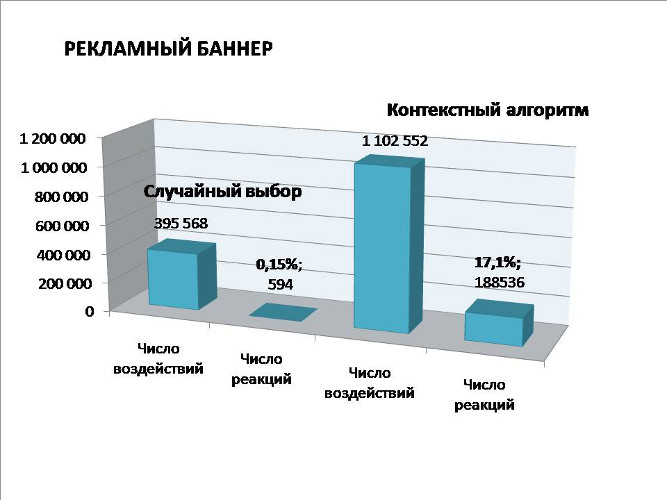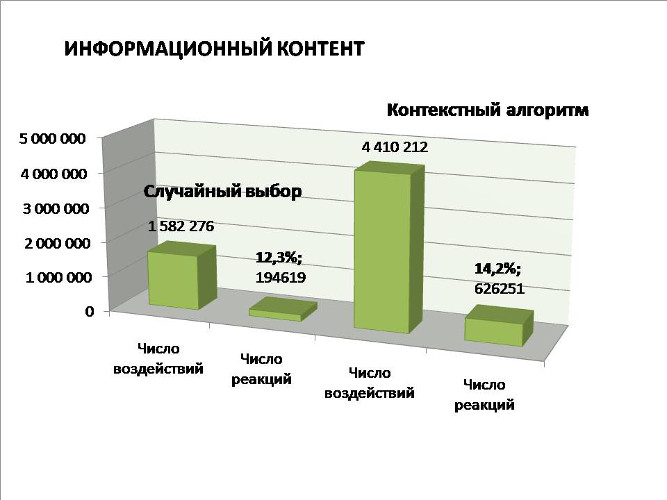The effectiveness of personalized recommendations: a contextual approach
Personal recommendations, as the first stage of personalizing the Internet as a whole, are aimed at facilitating the search for information. But the appropriateness of their use remains controversial.
We had the opportunity to evaluate the effectiveness of the most popular approaches to the formation of recommendations to the user. Our system processed the information received from several services (as partners), which offered their users recommendations for information content and advertising banners and recorded the user's reaction to them (click / no click). Thus, for the analysis we received 13.4 million recommendations based on different methods.

The number of content recommendations suggested to users. Other methods for recommending content included recommending popular content, content recommended by the user's friends, etc.
Most of the recommendations were generated using the context method. And not surprisingly, this is one of the most popular recommender methods on the market, with a number of advantages.
According to our data, the recommendations of advertising banners based on the contextual approach received 17% more positive reactions from users compared to recommendations that were formed randomly.

The effectiveness of contextual recommendations for advertising content
The number of positive reactions to recommendations of information content (articles, news) is 1.9% more than reactions to random recommendations.

Efficiency of contextual recommendations of information content
For comparison, the admissible error of our system is 2.4% of the entire processed data array. Therefore, we will not talk about the effectiveness of the contextual method in the field of information offers, but we note that the effectiveness of the contextual approach for recommending advertising content is already worthy of discussion.
Recall that the essence of this method is in offering the user content similar to that which had already provoked a positive reaction from the user. To offer “similar content,” the context method relies on keywords assigned to the content. Part of the effectiveness of his recommendations may lose due to errors in identifying similarities between the two units of content. Another factor that can reduce the effectiveness of recommendations is the inability to go beyond those whose information is available to the service on the user's previous activity. Recall Artemy Lebedev, who successfully outlined the logic of contextual advertising in the phrase: "here are your shoes, you bought shoes." For products that cannot be consumed by the user on a regular basis, this approach is ineffective.

The contextual method of recommendations locks users in several topics.
These problems lie in the field of implementation and can be eliminated with the development of contextual algorithms. But there are problems that cannot be eliminated by refinement and improvement of the algorithms, since they are caused by the features of the very principle of the context method. Such a conceptual flaw, we consider the lack of analysis of the individual characteristics of the user in the formation of selection forecasts.
In its recommendations, the context operates with patterns of behavior that are determined by the sociocultural characteristics of our society. For example, people go on a foreign tour with cameras, celebrate anniversaries in restaurants, buy pink clothes for newborn girls, and blue clothes for boys. But the number of such patterns is incommensurably smaller than the whole variety of reactions inherent in people. Human behavior is not limited to a certain set of schemes. Each choice, each action of the user is determined by his individual characteristics, current needs, internal resources that he has. Without clarifying the underlying patterns that force a person to perform one or another action, it is impossible to effectively predict his election.
It is also true that for advertising purposes, for now, knowledge about a person at the level that the context method owns is sufficient. More precisely, the level to which he aspires. The contextual method is applicable, first of all, where there is an unambiguous chain of actions for most users, regardless of their personal characteristics, while the advertising proposal is aimed at attracting a large number of consumers to the product. But the contextual approach to personalization methods can be attributed very conditionally - the criteria of a personal offer imply individuality, focus on a specific personality, its individual preferences, interests and needs, familiar life scenarios, motives and desires.
The world in which we all live - our social habits, mentality, and features of our everyday life, undoubtedly determines our actions, but our internal processes, motives and views determine exactly the world in which each of us lives. And the picture of the world of user-1 can differ significantly from the picture of the world of user-2, and even the notorious social trends that unite us all are transformed into something completely individual in the psyche of everyone.
Therefore, being effective in the field of an advertising proposal, the contextual method will not be successful in recommending information content, as in other areas for which the importance of individuality is paramount - assistance in the search, the field of dating, the formation of personal magazines and news feeds.
Thus, it should be recognized that the contextual method can be effectively applied in a number of areas, in particular in the field of advertising offers. It is unlikely that in the near future there will be a method for a better selection of related products. It is possible to supplement the contextual approach with other algorithms, but, from our point of view, it is the context that will form at least 80% of the entire proposal.
Nevertheless, you should not try to turn it into a panacea and solve with it the tasks related to personalization.
The article was co-written by Oksana Khrebtova, Alexander Golovan.
We had the opportunity to evaluate the effectiveness of the most popular approaches to the formation of recommendations to the user. Our system processed the information received from several services (as partners), which offered their users recommendations for information content and advertising banners and recorded the user's reaction to them (click / no click). Thus, for the analysis we received 13.4 million recommendations based on different methods.

The number of content recommendations suggested to users. Other methods for recommending content included recommending popular content, content recommended by the user's friends, etc.
Most of the recommendations were generated using the context method. And not surprisingly, this is one of the most popular recommender methods on the market, with a number of advantages.
According to our data, the recommendations of advertising banners based on the contextual approach received 17% more positive reactions from users compared to recommendations that were formed randomly.

The effectiveness of contextual recommendations for advertising content
The number of positive reactions to recommendations of information content (articles, news) is 1.9% more than reactions to random recommendations.

Efficiency of contextual recommendations of information content
For comparison, the admissible error of our system is 2.4% of the entire processed data array. Therefore, we will not talk about the effectiveness of the contextual method in the field of information offers, but we note that the effectiveness of the contextual approach for recommending advertising content is already worthy of discussion.
Recall that the essence of this method is in offering the user content similar to that which had already provoked a positive reaction from the user. To offer “similar content,” the context method relies on keywords assigned to the content. Part of the effectiveness of his recommendations may lose due to errors in identifying similarities between the two units of content. Another factor that can reduce the effectiveness of recommendations is the inability to go beyond those whose information is available to the service on the user's previous activity. Recall Artemy Lebedev, who successfully outlined the logic of contextual advertising in the phrase: "here are your shoes, you bought shoes." For products that cannot be consumed by the user on a regular basis, this approach is ineffective.

The contextual method of recommendations locks users in several topics.
These problems lie in the field of implementation and can be eliminated with the development of contextual algorithms. But there are problems that cannot be eliminated by refinement and improvement of the algorithms, since they are caused by the features of the very principle of the context method. Such a conceptual flaw, we consider the lack of analysis of the individual characteristics of the user in the formation of selection forecasts.
In its recommendations, the context operates with patterns of behavior that are determined by the sociocultural characteristics of our society. For example, people go on a foreign tour with cameras, celebrate anniversaries in restaurants, buy pink clothes for newborn girls, and blue clothes for boys. But the number of such patterns is incommensurably smaller than the whole variety of reactions inherent in people. Human behavior is not limited to a certain set of schemes. Each choice, each action of the user is determined by his individual characteristics, current needs, internal resources that he has. Without clarifying the underlying patterns that force a person to perform one or another action, it is impossible to effectively predict his election.
It is also true that for advertising purposes, for now, knowledge about a person at the level that the context method owns is sufficient. More precisely, the level to which he aspires. The contextual method is applicable, first of all, where there is an unambiguous chain of actions for most users, regardless of their personal characteristics, while the advertising proposal is aimed at attracting a large number of consumers to the product. But the contextual approach to personalization methods can be attributed very conditionally - the criteria of a personal offer imply individuality, focus on a specific personality, its individual preferences, interests and needs, familiar life scenarios, motives and desires.
The world in which we all live - our social habits, mentality, and features of our everyday life, undoubtedly determines our actions, but our internal processes, motives and views determine exactly the world in which each of us lives. And the picture of the world of user-1 can differ significantly from the picture of the world of user-2, and even the notorious social trends that unite us all are transformed into something completely individual in the psyche of everyone.
Therefore, being effective in the field of an advertising proposal, the contextual method will not be successful in recommending information content, as in other areas for which the importance of individuality is paramount - assistance in the search, the field of dating, the formation of personal magazines and news feeds.
Thus, it should be recognized that the contextual method can be effectively applied in a number of areas, in particular in the field of advertising offers. It is unlikely that in the near future there will be a method for a better selection of related products. It is possible to supplement the contextual approach with other algorithms, but, from our point of view, it is the context that will form at least 80% of the entire proposal.
Nevertheless, you should not try to turn it into a panacea and solve with it the tasks related to personalization.
The article was co-written by Oksana Khrebtova, Alexander Golovan.
